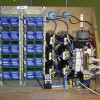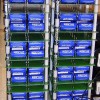Many inverter-supplied networks have a relatively low fault level, caused by the fact that most commercial inverters cannot supply more than 120% of their rated current. In such networks, a protection philospophy based on traditional fuses or circuit breakers may not be compatible with such a low fault level.
The Fault Current Source (FCS) is a device that can be placed in parallel with a distribution network to deliver additional fault current. For this purpose, the FCS stores a suitable amount of energy in a supercapacitor bank and releases this energy into the network once a fault situation is detected. In normal situations, the FCD remains passive, apart from regularly topping up the supercapacitor bank.
The FCS uses an inverter to discharge the energy into the network. The same inverter also serves as a charging power supply for the supercapacitors.
An FCS can provide existing wind turbines with a fault response characteristic compatible with the requirements made on newly installed units.
In the framework of a research project, a single phase prototype has been developed, built and tested. Results have been presented at the CIRED Conference in Prague, 2009, paper 0369.
The design of the FCS is protected by several patents.
Technical specifications:
|
Rated fault level |
45 kVA |
|
Rated AC voltage |
230 V |
|
Max. fault current |
200 A |
|
Max. DC voltage |
840 V |
|
Available energy for fault current |
80 kJ |



